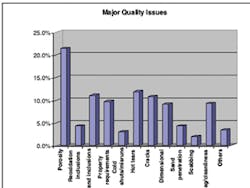Core and Mold Gas Evolution
According to a survey of 121 product engineers, design engineers, metallurgists, laboratory personnel, and others associated with the design, production, and use of castings, the metalcasting industry’s greatest need for improvement lies in eliminating porosity in castings. By consensus, this applies to aluminum, gray iron, and ductile iron, and to all types of steel castings. The distribution of quality issues based on this broad survey is shown in Figure 1. Concerns over porosity rated twice as high as any other issue in the survey.
One researcher addressing this concern is Leonard Winardi, a Ph.D. candidate at the University of Alabama- Birmingham. He has developed three techniques for determining gas pressure in molds: inserting a probe attached to a pressure transducer in cores; immersing samples in molten metal to various depths, depending on the calculated gas pressure in the mold or core; and observing whether or not bubbles are ejected, and observing gas evolution from cores during pouring in a real-time X-ray unit. Any or all of these three techniques may be used to determine peak pressures, at least in simple cores.
Winardi measured the volume and rate of gas evolution from a core produced in a commercial foundry, and calculated the pressure inside the core as a function of time (see Fig. 2). The binder being used produced two gas-evolution peaks which resulted in two gas-pressure peaks. The peak calculated pressure was almost identical to the peak measured pressure. Further improvements in the shape of the pressure curves may be obtained when more accurate information on the composition of the gases produced is obtained.
Winardi’s theory of gas-bubble formation in castings is that if the gas pressure in the mold or core exceeds the metal head pressure, gas will bubble from the core or mold into the metal. A gas rate of evolution curve is illustrated in Figure 3. If the metal head pressure can be developed faster than the gas pressure, as illustrated by the red line (a’), the release of gases into the mold cavity is suppressed, and gas is forced through the core prints. If the pouring rate is lower, as illustrated by the red line (a), the gas pressure exceeds the metal head pressure for a period, and during this time, gas bubbles through the metal to produce dross, oxide folds, and slag defects. The importance of the peak rate of gas evolution in relation to the pouring rate helps to explain why gas defects can sometimes be eliminated by gate changes to pour the casting faster. Sometimes, blows also can be eliminated by pouring hotter to allow the bubbles to blow through the metal. This does not eliminate dross formation, but it may allow the gas to exit the casting.
Winardi present his research at a meeting last spring of The Foundry Casting Porosity Reduction (CPR) Consortium, a collection of producer and supplier companies worldwide aiming to address the quality concerns relating to porosity.
The leader of the consortium is AlchemCast L.L.C., and its founder Dr. Charles Bates presented data on the volumes and rates of gas evolution from a variety of cores in contact with aluminum, iron, and steel, from which pressures can be calculated. Two such curves obtained when an epoxy acrylic resin-bonded core in contact with iron are illustrated in Figures 4 and 5. The resin bonded sample illustrated in Figure 4 produced gas-evolution rates of up to 15 cc/sec., about 10 seconds after contact with iron at 2,400°F. A coated core that had been dried in a foundry produced the gas evolution volumes and rates illustrated in Figure 5. The dried coating moved the peak rate to a shorter time after contact, and increased the peak rate to about 26 cc/sec. The high peak rate and short time after pouring would aggravate the tendency for gas produced to blow into the metal before a skin could form.
Andrei Starobin of Flow Science Inc. outlined an approach for using core-gas evolution data from simple cores to model the core pressure in complex cores, such as water jacket cores and oil passages. Starobin can approximate the gas pressure inside cores from first principles of resin pyrolysis using hydrogen evolution and water decomposition. He outlined further work needed, including model verification in foundries, and making the code input and output more user friendly.
The global consortium involves casting producers, resin and coating suppliers, additive and sand suppliers, and academics, and it was formed to address the issues surrounding the volume of porosity in castings, and how to reduce it. The consortium will focus on gas evolution from molds and cores, with a small effort on metal turbulence and gas entrainment during pouring. The next step will be to determine the volume of gas produced by core and mold materials that are used by participating companies.
In addition, the consortium will measure the true permeability of the core and mold samples, because the permeability determines how easily the gas can escape, as well as how fast the pressure builds up in the core or mold. If the local pressure exceeds the metal-head pressure, gas will blow into the casting.
Finally, the consortium will work to develop a model of the gas pressure in commercially interesting cores with various metal thicknesses surrounding the core.
Excerpted from FM&T May 2007 issue, p. 17.
